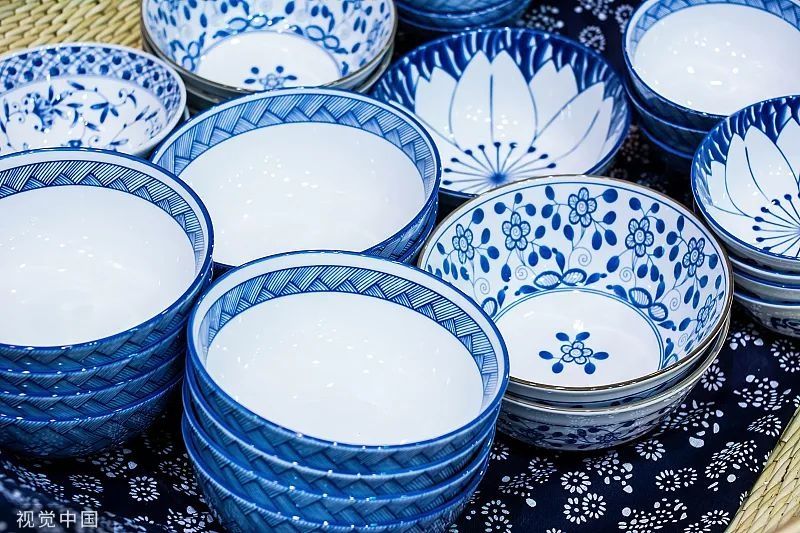
Ceramic bowls, imitation porcelain bowls, stainless steel bowls, plastic bowls, wooden bowls, glass bowls… Which one do you use at home? A bowl? For daily dry rice, bowls are one of the indispensable tableware. But have you paid attention to the bowls used for eating? Today, let’s see which bowls are inferior and what kind of bowls should be selected.
1
What are the possible hazards of imitation porcelain bowls? The texture of the imitation porcelain bowl is similar to that of ceramics. Non-stick oil and easy to clean, it is widely favored by restaurant owners. Imitation porcelain bowls are generally made of melamine resin material. Melamine resin, also known as melamine formaldehyde resin, is a resin formed by the polycondensation reaction of melamine and formaldehyde, which is bonded and thermally cured under high temperature conditions. Seeing this, many people are full of questions, “melamine”? ! “formaldehyde”? ! Isn’t this poisonous? Why can it still be used as cutlery? In fact, the quality melamine resin tableware will not produce formaldehyde and other harmful substances during normal use. Melamine resin tableware produced by regular factories will generally have a logo, indicating that The use temperature is between -20℃ and 120℃. Generally speaking, melamine resin is at room temperature. Completely non-toxic. The temperature of the hot soup generally does not exceed 100℃, so you can use a bowl made of melamine resin to serve the soup. But cannot be used to hold freshly fried chili oil, because the temperature of chili oil is about 150℃, which will melt the melamine resin and release formaldehyde under such high temperature conditions . At the same time, studies have shown that the migration of formaldehyde increases significantly after using imitation porcelain bowls to contain vinegar at 60°C for 2 hours. Therefore, It is not recommended to use imitation porcelain bowls for a long time. Acidic liquids. In some small factories, due to the poor quality of the craftsmanship, the raw formaldehyde will remain in the bowl if the raw material is not fully reacted. When the surface of the bowl is damaged, it will be released. Formaldehyde has been identified by the World Health Organization as a carcinogenic and teratogenic substance, and has become a major killer that threatens human health.2
The heavy metal in the stainless steel bowl exceeds the standard? Compared with ceramic bowls, glass bowls, imitation porcelain bowls and other bowls, stainless steel bowls are the most durable. Stainless steel is usually made of iron as a matrix, and then smelted with chromium, nickel, manganese, molybdenum and other metals, and metal impurities such as lead and cadmium are also mixed. Using inferior stainless steel bowls to hold food, the above metal elements are likely to migrate, and accumulation in a certain amount in the human body will lead to heavy metal poisoning. The researchers used an inductively coupled plasma mass spectrometer method to measure arsenic, cadmium, lead, chromium, zinc, nickel, manganese, copper, The migration of aluminum, iron, cobalt, molybdenum and other metal elements, using this method to test nearly 30 different batches of stainless steel tableware, the above twelve elements were detected. The migration of metal elements in stainless steel tableware has a certain relationship with its content. The higher the content, the greater the migration of metal elements. At the same time, the study also shows that the migration of metal elements in stainless steel bowls gradually decreases as the number of uses increases. New stainless steel bowls are more likely to migrate more metal than old stainless steel bowls. . 3
< hr/>
Which bowl is the safest? plastic Bowls and Imitation Porcelain Bowls Substandard plastic or imitation china bowls are at risk of migration of formaldehyde and other harmful organics when serving hot soup. If a steel ball is used to clean the bowl, the resulting microplastics can also be ingested by the human body. Improper use may lead to the risk of migration of harmful metal ions, so is not suitable for holding acidic liquids such as vinegar or lemon juice for a long time. Bacteria and mold tend to grow in humid environments, although some wooden bowls And the surface of the bamboo bowl is coated with a layer of paint to prevent the growth of microorganisms, but this layer of paint has the risk of falling off and being ingested by the human body. Therefore, is best used to hold some drier foods. High chemical stability, and qualified tempered glass bowls and ceramic bowls are resistant to With good thermal performance, can hold food at any temperature without considering the risk of migration of harmful substances. 
< span>4
How to choose bowls with different materials? Plastic and Imitation Porcelain Bowls At present, most household “plastic bowls” or “imitation porcelain bowls” on the market are made of melamine resin. It is best to buy well-known brand melamine resin bowls in large shopping malls. Don’t Buy “imitation porcelain bowls” that are much lower than market prices. The merchants of regular imitation porcelain bowls will generally mark the bowls with explanatory marks. According to the specific ingredients, they are divided into: A1, A3, A5, A8, be sure to choose A5 or A8, the performance of high temperature resistance will be better. Another type of plastic bowl is the popular wheat straw plastic bowl. When purchasing, you must pay attention to whether the material at the bottom of the bowl is marked with “wheat straw”. Some bowls made of “starch” will also pretend to be wheat. straw bowl. When purchasing, check whether the label on the bottom of the bowl has QS mark and product quality certificate, etc. The nickel content, if the chromium content is about 18% and the nickel content is about 9%, you can buy it with confidence! According to different processes, it is divided into: ordinary glass bowls, tempered glass bowls and high borosilicate heat-resistant glass bowls. identification to distinguish. Ordinary glass bowl strength Low, easy to break, easy to burst when cooled and heated quickly The tempered glass bowl has good “drop resistance”, and the general maximum working temperature does not exceed 300℃ The high borosilicate glass bowl has strong high temperature resistance, and the working temperature can reach 450℃< /span>
The chemical properties are stable, and there are generally no safety problems. You can buy with confidence.[Source: Xinhuanet]
Disclaimer: The copyright of this article belongs to the original author. If the source is wrong or infringes your legal rights, you can contact us by email. We will deal with it promptly. Email address: [email protected]



